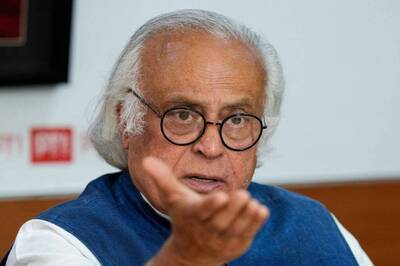
views
Rain and wind lashed India's east coast on Saturday, forcing more than 400,000 people to flee to storm shelters as one of the country's largest cyclones closed in, threatening to cut a wide swathe of devastation through farmland and fishing hamlets.
Filling most of the Bay of Bengal, cyclone Phailin was about 200 km (124 miles) offshore by noon on Saturday, satellite images showed, and was expected to hit land by nightfall.
It was on the verge of becoming a "super cyclone", and was expected to affect 12 million people, officials said.
"This is one of the largest evacuations undertaken in India," said Shashidhar Reddy, vice chairman of the National Disaster Management Authority, who estimated that more than 440,000 people had been evacuated.
But the size of the storm made extensive damage to property more likely, he told reporters in New Delhi. "Our priority is to minimise loss of life."
In Donkuru, a fishing village in the southeastern state of Andhra Pradesh that is expected to catch the eye of the storm, people said they hesitated to leave because they had small children, despite buses provided by the authorities to take them away.
Amid howling winds, a group huddled at a bus stop waiting for a ride out of town while the wind snapped tree branches like toothpicks and the rain hammered down.
"We're waiting for the bus, but it's not coming," said L Ram, an anxious fisherman. Nearby, a woman cradled her one-and-a-half year old son in one arm and struggled with a plastic bag filled with clothes on the other.
"I have a small child, so I thought, how will I leave?" asked Achamma, 25, as she clutched on to the boy, Ganesh. At the coastal front of the village, roll after roll after roll of power packed waves crashed onto the beach.
In a statement, the India Meteorological Department said Phailin was packing winds of between 210 kph (130 mph) and 220 kph (137 mph) and was expected to cause a 3.4-m (11-foot) surge in sea levels when it hit the coast.
The weather department warned against extensive damage to mud houses, the major disruption of power and communication lines, and the flooding of rail tracks as well as escape routes set up to flee disasters, with flying debris another threat.
Heavy rains left lush green fields sodden with water along the Andhra Pradesh coast.
"We are ready to evacuate," said Jagdesh Dasari, 35, the wiry-haired chief of the fishing village of Mogadhalupadu, which has 2,500 residents, as the rain sheeted down.
"If the waves come higher, the whole place will vanish."
In neighbouring Odisha state, Muslims and Hindus flocked to mosques and temples to pray Phailin would not wreak the kind of havoc left by a similar storm 14 years ago that killed 10,000 people.
In the first death reported before the storm made landfall, a 40-year-old woman in the state capital, Bhubaneswar, was killed when a tree uprooted by the heavy rain fell on her early on Saturday.
"The wind speed is picking up," said Pradeep Kumar Mohapatra, the state's special relief commissioner. "Some people were earlier reluctant to move. They are willing now."
Families trekked through the rain to shelters as gusts of wind snapped branches from trees. Tourists left Puri, a popular beach resort. Officials broadcast cyclone warnings through loudspeakers, radio and television.
London-based Tropical Storm Risk classed the storm in Category 5 - the strongest such rating. The US Navy's weather service said wind at sea was gusting at 314 kph.
Some forecasters likened the cyclone's size and intensity to hurricane Katrina, which tore through the US Gulf coast and New Orleans in 2005.
It also evoked memories of an Indian storm in 1999, when winds reaching speeds of 300 kph battered Odisha for 30 hours.
This time, however, the Odisha government said it was better prepared. Half a million people are expected to shelter in schools and other strong buildings when the storm hits, officials said. At least 60,000 people left their homes in neighbouring Andhra Pradesh on Friday.
India's eastern naval command, based in the Andhra Pradesh port of Vishakapatnam, was on alert and shelters were being stocked with rations. All leave for government employees was cancelled.
Police said a rescue effort was launched for 18 fishermen stranded four nautical miles at sea from Paradip, a major port in Odisha, after their trawler ran out of fuel.
Paradip halted cargo operations on Friday. All vessels were ordered to leave the port, which handles coal, crude oil and iron ore. An oil tanker holding about 2 million barrels of oil, worth $220 million, was also moved, an oil company source said.
But the storm was not expected to hit India's largest gas field, the D6 natural gas block in the Cauvery Basin further down the east coast, field operator Reliance Industries said.
Katrina hit the U.S. Gulf coast on August 29, 2005, killing about 1,800 people, and causing damage of around $75 billion. It was one of the six biggest hurricanes - also known as cyclones and typhoons - ever recorded.
Andhra Pradesh has set up a round-the-clock control room in the State Secretariat in Hyderabad.
The control room numbers are: 040-23456005/23451043 and Fax- 040-23451819.
Emergency control room numbers - 08942 240557 and +91-652838191 in Srikakulam district.
Toll free number 180042500002 was announced as the Phailin emergency number.
The helpline number of the Odisha Central Control Room - 0674-2534177.




















Comments
0 comment